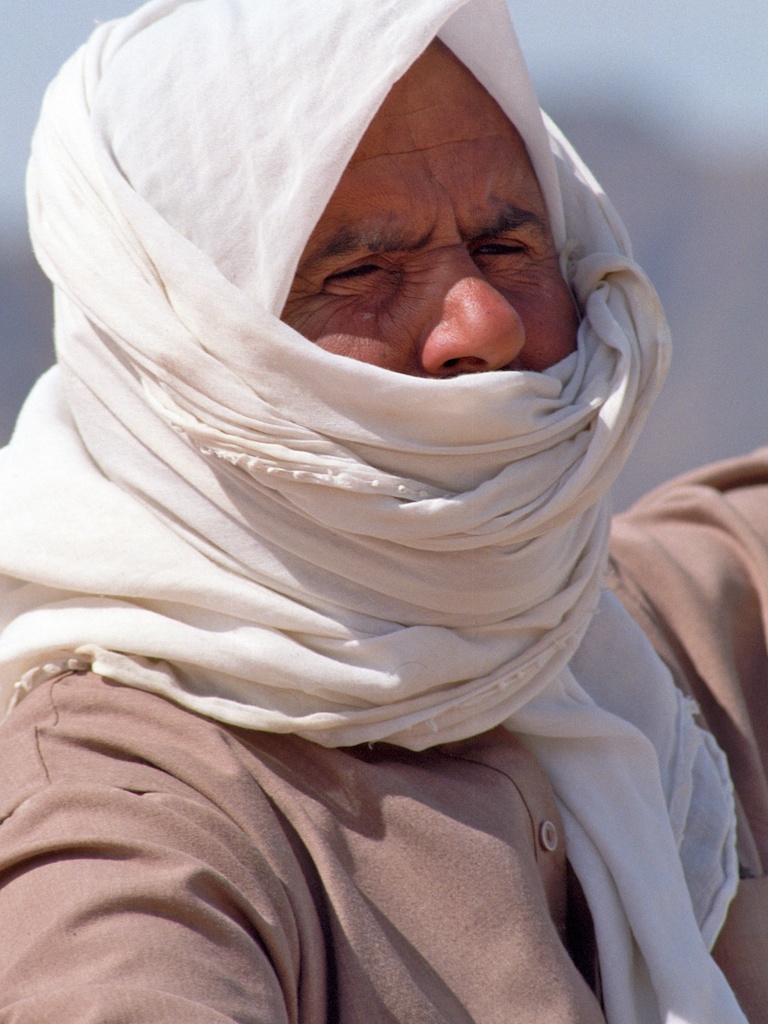
Egypt: Soul of the Desert
Soul of the Desert
by Lester Picker
[This article originally appeared in The Baltimore Sun Travel section.]
The ringing in my ears has finally stopped. Only now, for the first time since I arrived 36 hours ago, can I hear the true sound of The Great Sakhara, Egypt’s Eastern Desert. Silence. Utter, absolute, total quiet. A silence far, far deeper than even Thoreau’s New England forest solitude.
In the desolate landscape of The Great Sakhara there are no tree leaves to rustle in the wind. In fact, other than for a short time in the morning and evening, there is no wind. Trees, like the acacia, are few and laced with thorns and rigid, needle-like leaves. There are no sounds of babbling brooks. No crickets chirping. No car engines in the distance or airplanes buzzing overhead. Just a silence like I have never experienced before in my life, a stillness that strips away the noisy veneer of our twenty-first century existence and penetrates to one’s core.
On the surface, I have come to this desert to research material for a book I am writing. But, I soon realize that this immense tract of barren sands, with its deeply etched mountains and boulder-strewn wadis has its own agenda. Sheikh Abdel Zaher Soliman, my guide and a Bedouin leader of the Ma’aza tribe of the Khushmaan clan knows this. He has waited patiently for its effects to take hold on me. I tell him with wonder what has just happened to me and he smiles, one of the many smiles of acknowledgement I will see on his face over the next few days. Abdel Zaher tells me that those infrequent visitors who do come here carry inside their heads the noises from where they came. And then The Great Sakhara works its magic.
An inauspicious beginning
I found out about Abdel Zaher (pronounced Abdel Zahr) through a colleague who spent years living with the Bedouins. But, finding Abdel Zaher in concept and finding him in the flesh are two different things. He has no real address, other than a neighborhood at the edge of the Red Sea resort town of Hurghada.
I finally located his house by asking several people in the neighborhood. I arrived at 1:00 on a hot afternoon, about an hour behind schedule. I was greeted by one of Abdel Zaher’s 15 children, who brought me inside to meet Mona Farouk, one of Abdel Zaher’s two wives, a gracious woman who welcomed me warmly.
Abdel Zaher, she explained, was “in the desert.” He would return when he returned. Period. Sit down, eat, make yourself comfortable. In the four hours spent in their modest house, I was introduced to more than half his children and many relatives. The children flow freely from one mother’s household to the other, and each refers to both women as their mother. A little after 5:00 that evening, Abdel Zaher appeared, amidst much fanfare.
Abdel Zaher Soliman is a small, sinewy and very, very proud Bedouin, the last of a dying breed of nomadic people. His father was a revered Bedouin leader and as a child and young man Abdel Zaher grew up roaming the Eastern Desert from the Nile River to the Red Sea along a wide swath traditionally belonging to his clan. Now, as more and more Bedouins opt for life in small cities, Abdel Zaher makes his living as a desert guide for people serious about learning the desert’s ways. Unfortunately, Abdel Zaher speaks no English, although I suspect that he knows a few words but simply refuses to use them.
The next morning, we started early, buying fresh fruits, vegetables, breads and cheeses for the trek. Since Bedouins eat meat infrequently, and I am a vegetarian, we finish at the souk in less than 30 minutes, throwing the provisions and our gear into the back of Abdel Zaher’s battered, front-wheel drive Toyota pickup.
Driving out of Hurghada, the stark desert mountains to the west loom into view, larger and more forbidding with every passing mile. Abdel Zaher starts a dialogue that will form the basis of our communications, and one that will improve my Arabic language skills immensely over the next four days. When he explains something he stops and asks if I understand him. If not, he patiently, softly, repeats himself, drawing objects in the sand, or gesturing until I understand him clearly. I write down words and expressions that are new to me, which pleases him greatly.
Ninety minutes into the drive we reach a “Bedouin village” staged for day-trek tourists, although several of Abdel Zaher’s family and friends actually do live there, in a section off-limits to tourists. Like two of Abdel Zaher’s relatives I met in his house, I notice that several of the children are deaf mutes, the result of inbreeding. When I ask Abdel Zaher about it, he explains that is Allah’s way, but that all people within the tribe contribute to daily chores and are loved, an acceptance I see repeatedly throughout my stay. We sip tea with a friend of his father’s, then leave to drive another six hours into the deep desert.
The Eastern Desert
The Ma’aza tribe traditionally roamed an area of some 56,000 square miles, roughly the size of the state of Indiana, occupying about 8.5% of Egypt’s land mass. The area is so inhospitable, it has one of the lowest population densities on earth, fewer than one person per sixty square miles. It has not rained in the Eastern Desert for five long years. Yet, even when it does, annual rainfall averages about one-tenth of an inch. During summer, temperatures can reach over 110 degrees Fahrenheit for days and nights at a time. During winter, when I am here, temperatures can reach 90 degrees during the day and plummet to freezing at night.
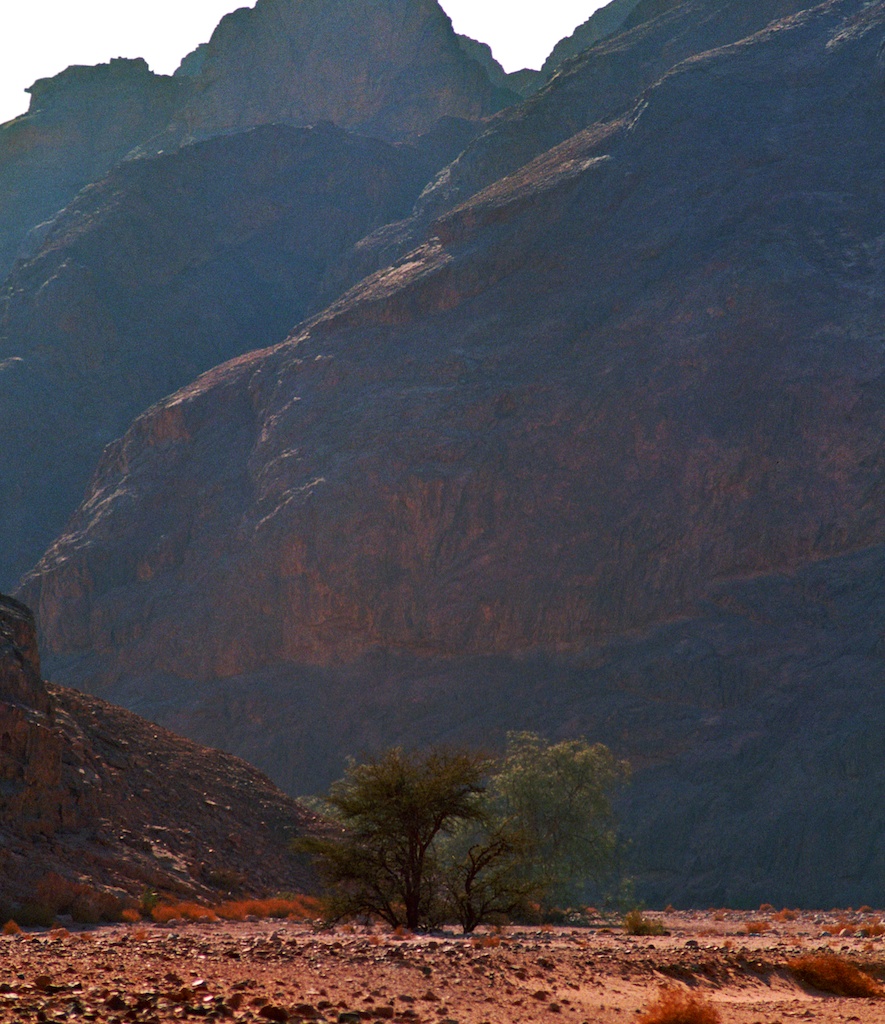
Driving in the Eastern Desert is an endless series of detours. The mountains are so steep, rising in places to more than 7,000 feet, and so impossibly rugged and devoid of plants, they cannot be traversed easily by foot or at all by vehicle. So, driving from one point to another involves traveling in the dry river and sea beds, known as wadis. You travel from one sand and rock-strewn wadi to another to get around a mountain. Since a wadi might be miles long, the process is a first rate geography lesson in why caravan routes were so important and well defined in ancient cultures. In an environment where temperatures can be so brutal, you had better know intimately where water, game and good shelter can be found.
The Eastern Desert’s mountains were also the source of much of ancient Egypt’s gold, although their uncanny ability to discover and mine the precious metal left subsequent prospectors high and dry. A recently discovered, 2,900 year old papyrus pinpoints the location of the old Pharaonic mines and a new venture is seeking to extract gold from those deposits.
At a watering hole, I ask Abdel Zaher about another valuable resource, the Nubian goats that are ever-present in Bedouin camps. He explains to me the process of making water bags from goat skins. Since resources are so precious to a subsistence people, the goat is fully utilized, from the hide (think not-yet-prime-time Gucci bags) and meat (usually only on festive occasions), to the horns (medicine containers, knife handles and decorations), and sinew (for sewing).
As we drive through the heat and dust, I notice isolated trees here and there, scattered unpredictably in the sun-baked wadis. These are acacia trees, made famous in antiquity by the ancient Egyptians who utilized every part of this valuable resource. The spiny leaves of every orange-trunked tree we pass is eaten up to the reach of camels.
Finally, after a full day of driving, taking notes and photographing the striking beauty of the desolate landscape, Abdel Zaher chooses a spot to make camp. With the sun beginning its long process of setting behind the mountains, I help Abdel Zaher pick some dried brush, which he breaks up and carefully arranges in the firepit. He then scoops up a large pile of dried camel dung, each oval pellet about the size of a prune, into his robe and dumps them into the firepit, then lights the mixture with a match. The dung makes a great fire and I find, much to my surprise, smells good, too.
With the fire now generating the hot coals Abdel Zaher will need to cook in, I’m able to relax and I turn to see the sun setting behind the mountains to our west. The sunlight, filtered through desert dust, paints a canvas of warm reds and vivid oranges that are breathtaking, bathing the eastern mountains of our wadi in a warm golden glow .
Dinner for two
With the light fast fading, we eat a meal of beans and spices, known as fool, heated in a small pot on the edge of the coals. We take turns scooping up portions of the flavorful beans with pieces of whole wheat pita bread, called eish baladi, heated by throwing them into the coals for a few seconds (yes, camel dung and all) to warm them up. We also dip our bread into a creamy feta cheese and munch on fresh vegetables.
As soon as we finish dinner, Abdel Zaher quietly moves away from the fire, turns toward Mecca, and begins his evening prayers. I marvel at the intimate connections this man has with his environment and his God.
Turning in
By 8:00 PM, we are more than ready for sleep. Abdel Zaher makes a semi-circular windbreak from dried brush to shelter us from the evening winds that will soon begin. We prepare the sand, Abdel Zaher’s colorful, woolen Bedouin blankets and my sleeping bag and climb in. But, as the night sky darkens to pitch black, I am awed by the crystal-clear light show taking place overhead. Abdel Zaher draws in the sand for me how the Bedouins use the rotation of the constellations to follow the seasons. He also points out to me a diffuse light source on the horizon that I would never have noticed on my own. It is the lights from Luxor, some 200 kilometers away. When he was a child, the desert was truly black at night, he sighs.
We also discuss religion and Abdel Zaher’s intolerance for Muslim fundamentalists who believe that there is only one way to know God. I fall asleep, content, as the gentle winds begin to flow across the desert floor.
Suddenly, after midnight, I am awakened by what seems like someone shining a flashlight in my eyes. It is the moon, shining so brightly, it lights up the entire wadi, bathing the surrounding mountains in a bright glow, as if someone had simply turned on a light switch. I also notice that the temperature has plummeted to just above freezing. I am finding it hard to keep warm and even my eyes hurt from the intense cold. I pull a spare t-shirt over my eyes and head to keep warm.
Day 2
At sunrise, I open my eyes to mountains bathed in a smoky, ethereal glow, lit in soft, warm copper tones by the early morning sun. Silence again. Total and complete silence, punctuated by Abdel Zaher’s regular breathing.
As Abdel Zaher prepares a simple breakfast for us, I note his slow and deliberate movements, a practice reinforced by an unforgiving environment where any mistake can be fatal. I am beginning to understand how the Eastern Desert afforded the ancient Egyptians such secure protection from invaders.
Abdel Zaher is eager to show me a special sight, so we soon pack and leave our campsite. As we drive, he is always telling me exactly where we are by naming each mountain, each wadi, each water hole. Knowing the names of geographical landmarks is critical in The Great Sakhara, because to give wrong directions can and has often meant death from dehydration. In his quiet voice, Abdel Zaher tells me he knows many people who have died this way. Along popular caravan routes, rock cairns, which the Bedouin call “rriggin,” mark trails to water or trade routes.
But, the naming process is made easier by one of the most unique aspects of the Eastern Desert. Its barren mountains are one of four distinct and separate colors, a striking feature that is riveting. Green, red, black and white mountains dominate one or another section of desert, the sand surrounding them reflecting their color. Yet the tones of those colors are ever-changing, as the sun moves across the sky.
The acacia preserve
It is now 5:00 PM and it is still 85 degrees, but I’m not sweating due to the dry desert air. But I am shivering a bit, because I am walking in one of the most unique spots of the Eastern Desert, a grove of some 1,200 acacia trees that the Bedouins have self-designated as a preserve. Concerned about overuse of the valuable trees, the grove stands as a silent reminder of similar groves that once dotted the desert but are no more.
But this grove is so spiritual, so elegant in its simple beauty, I am reminded of a Japanese Zen garden, except this one is in the middle of nowhere, completely surrounded by towering mountains in all four colors. While Abdel Zaher prays, I meditate on a ridge overlooking the acacia grove.
Today has been a wonderful day, full of learning about water sources, mountains and folk medicines made from plants. As night falls, I feel more attuned to the natural rhythm of the desert and to my own internal rhythm. I eagerly await the starry light show, but before I know it, my eyes close and reopen to the sun peeking above the nearby mountain.
Day 3: Tracking an Ibex
I start the day cleaning my cameras from the sand dust that covers everything here. Following a breakfast of tea, bread and cheese, we are off. In an hour, Abdel Zaher stops the truck, peers into the distance and gets out. We walk for about 15 minutes to the base of a mountain, where he stoops down and points out to me a set of tracks.
There have been gazelles here recently, he says, and an Ibex was here within the past hour, in all probability scared off by the sounds of our truck. He looks up at the mountain, and motions me back to the truck.
In a few minutes we stop along a ridge and I see a group of gazelles running across the wadi, perhaps a half-mile from us. They are a beautiful sight, with their tan shoulders and white underbellies, leaping and darting across the desert floor faster than I could have imagined.
Seeing my excitement, Abdel Zaher asks if I want to see an Ibex. We ride to the back of the mountain where he had first spotted the tracks and begin to climb. By mid-morning, Abdel Zaher motions for me to crouch and be quiet. He points. On a rock face some 100 feet ahead and above us is an incredible sight, a lone male Ibex, perched precariously on a rocky outcropping. We spend the next couple of hours following and photographing this perfect specimen.
Lessons in humanity and the divine
As each day’s adventures merged into the next, I began to settle into the desert experience and extract from it the lessons I had come to learn. Paramount among them is the relationship between the desert and its Bedouin people, an intricately interwoven connection that is both deep and profound.
One night I asked Abdel Zaher if he would come to America to visit me, so I could repay his being such a gracious host to me. “You must not have big deserts there,” he quietly told me, “because Americans come here to study The Great Sakhara. If you don’t have a desert like this, why would I want to go there?”
The relationship between the Bedouins and their environment is intertwined with their deep spiritual beliefs. Perhaps it is the time they have to contemplate, but I found the strong personal connections that Bedouins feel to God to be inclusive. Sitting by the fire one evening, Abdel Zaher confided in me his disdain for fundamentalist Muslim clerics who preach intolerance. “What difference is it if you are People of the Book (Jews) or Christians? We all worship Allah. Everyone should be left to do that as they wish.”
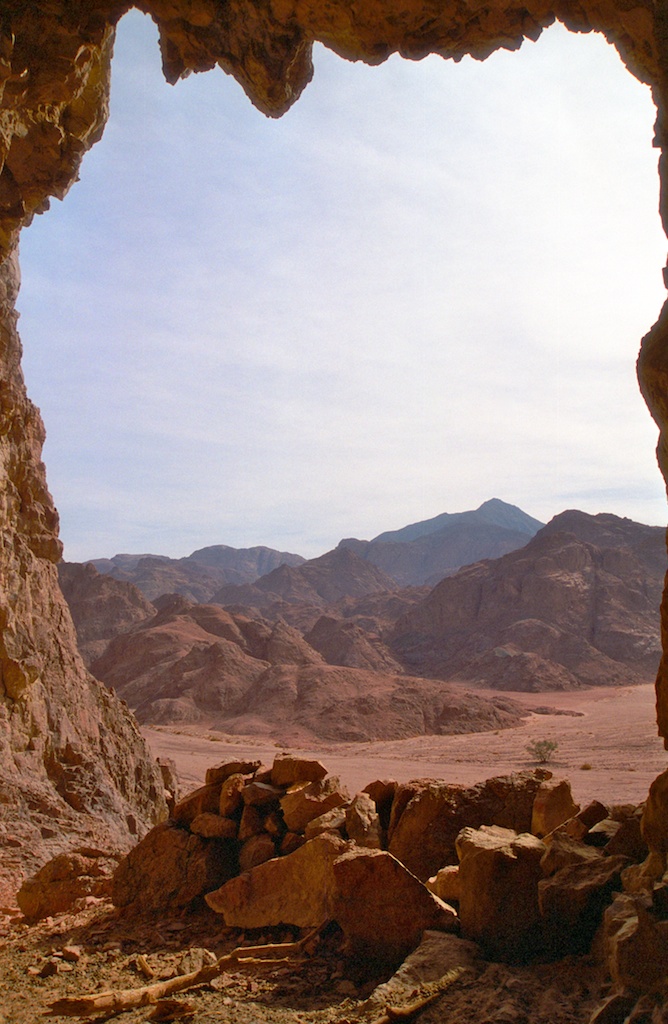
Late in the afternoon, I spotted a cave high up on a mountain. I asked Abdel Zaher if he would stop, so I could climb to it. He smiled and stopped, staying behind while I climbed up. The cave was certainly appealing from the ground, but it was absolutely awesome as I approached. A huge, nearly perfectly arched entranceway framed the shallow cave. The path going up and the floor of the cave itself was littered with ibex scat. The cave, some 700 feet up, had bat guano on its walls. A few broken branches littered the floor in one spot. But, it was the view from the cave that took my breath away. I was looking out over a panorama of desert wadi, framed by rugged mountains that had taken us over an hour to drive through, all in one vista.
I sat down and surrendered to the moment, to the silence and penetrating solitude of this magical place. I meditated, then noticed that Abdel Zaher had climbed the mountain from another direction and was standing next to me. Yes, he had visited here many times he told me, but not recently. Here were the sticks in the cave that he had stocked several years ago to make a fire in case a heavy rain surprised his tribe while they were in this wadi. We sat there a few more minutes. “You know,” I said to Abdel Zaher, “I can feel Allah’s presence here right now.” He smiled at me, reached over and held my hand in both his leathery hands. We sat like that for a few minutes before walking quietly back down the mountain.
Day 4: Relationships
Despite my eagerness to learn about the desert, if I were to be asked about what made my experience so unique, my answer would have to be the Bedouin people themselves. They are a people governed by daily relationships, by common bonds used to strengthen themselves to better cope with an environment that is one of the most unforgiving on earth.
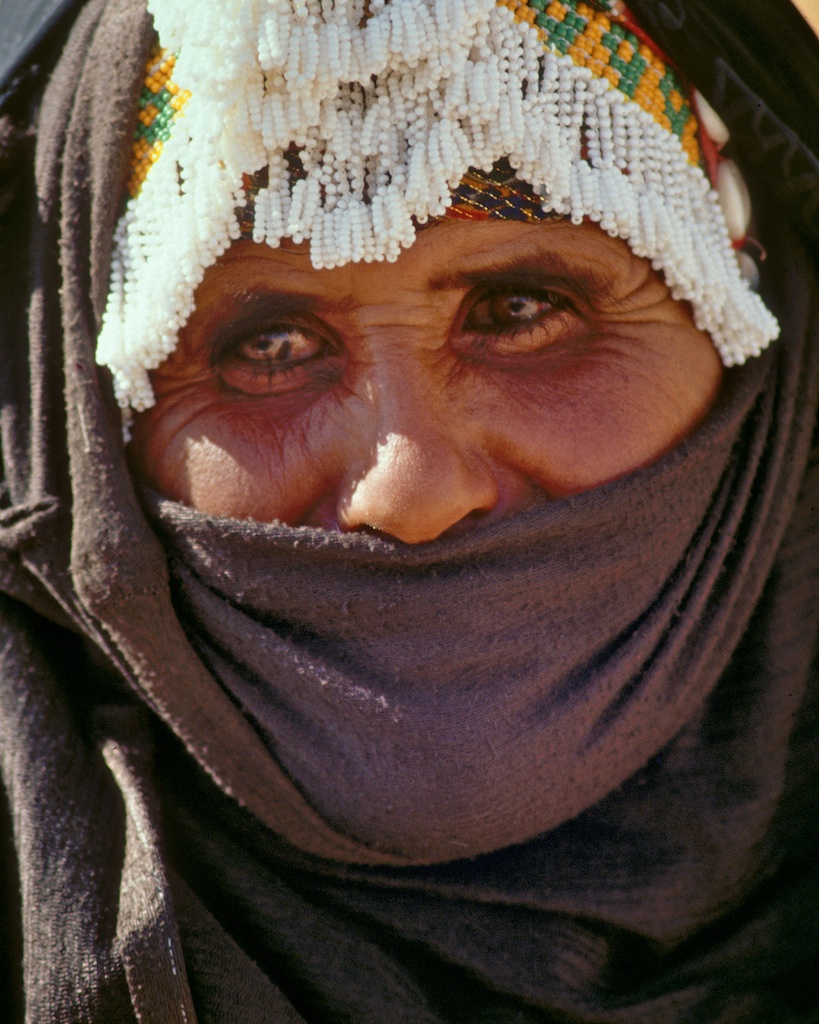
Throughout our trek, we would periodically pass a family of Bedouins living in the desert, usually at the base of a mountain. As a tribal leader, Abdel Zaher would stop each time to check on his people, which on several occasions ended up being one of his fifteen children or many grandchildren. Everyone would kiss and hug and greet Abdel Zaher, share stories and offer us food, usually tea and bread.
On our last day together, we drove for more than two hours, through wadis and around mountains to visit Abdel Zaher’s sister, Saida, whom he had not seen in weeks. Her family lived out in the open, their only shelter a rocky outcropping.
The joy on her face on seeing her brother was carved deeply in the wrinkles of her eyes, the only part of her face I ever saw. She and her brother hugged and kissed, then she poignantly grabbed his hand in both of hers and spent minutes kissing it and rubbing it gently on her cheeks. I was so moved by the experience, I felt tears welling in my eyes.
We feasted on fiteera, a flat bread Saida made from scratch, yogurt, fool, and creamed feta cheese with vegetables. We also had eggplants grilled directly in the coals of a camel dung fire. As we ate, Saida’s two young daughters played with a stack of empty film containers I gave them.
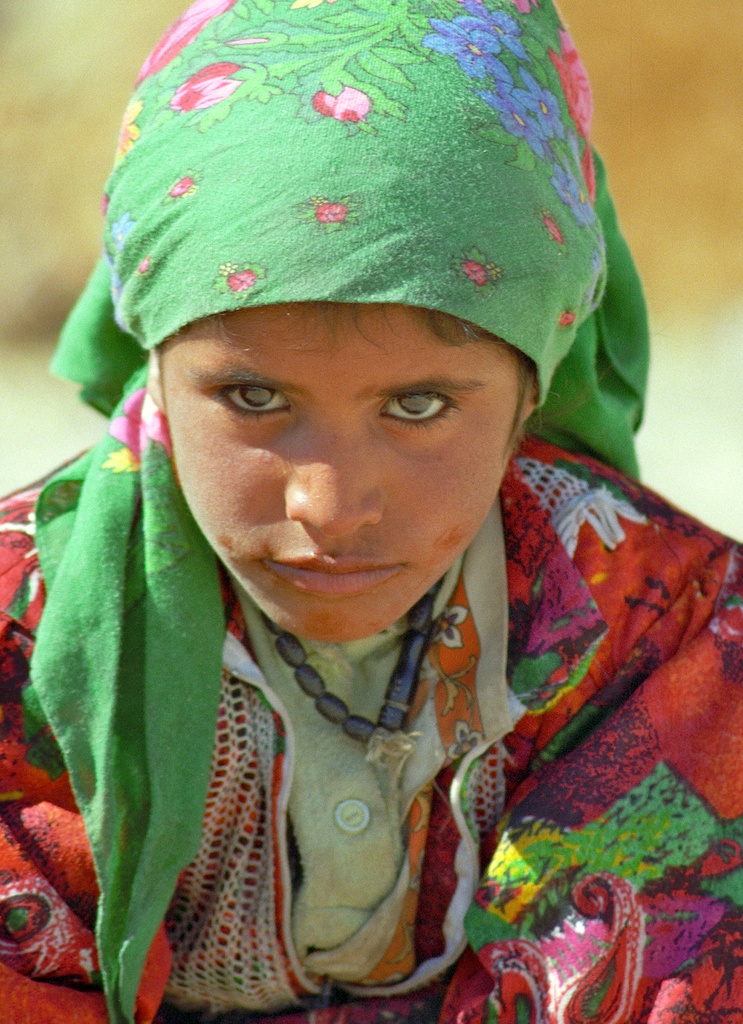
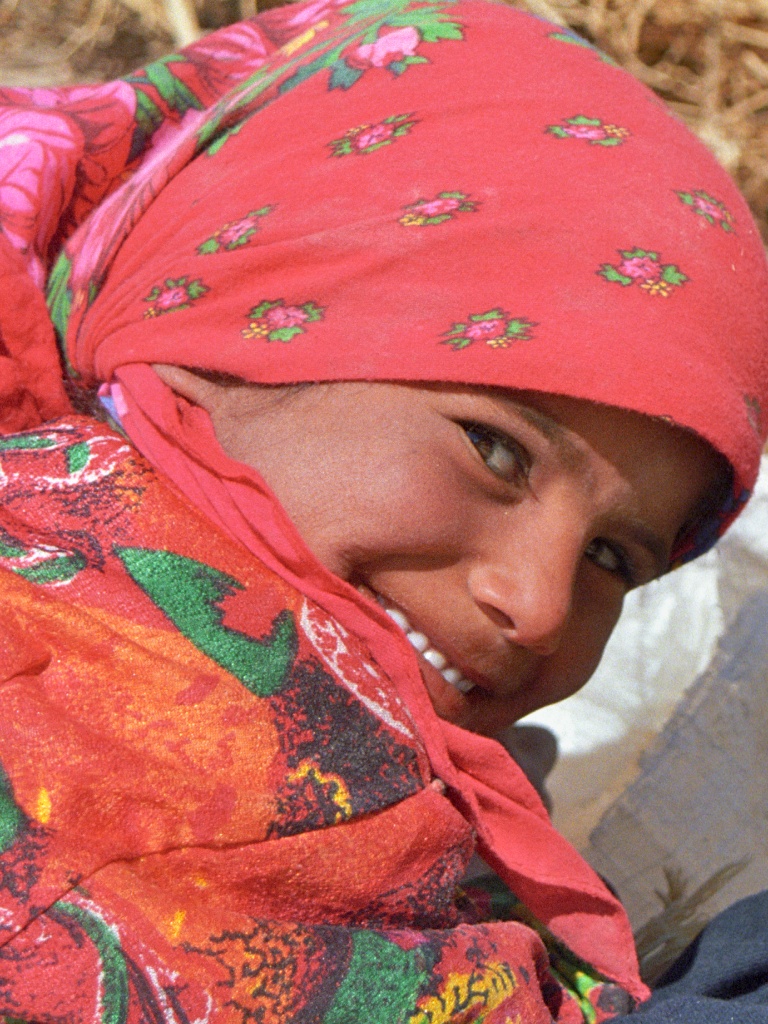
Driving back to Hurghada, I asked Abdel Zaher why he didn’t run day safaris and make lots of money like some of his relatives now do. “I’ve got so many blessings,” he said. “I’m the happiest man. I don’t need more money.” We drove in silence for another hour.
“Abdel Zaher, what will happen to the Bedouins in five or ten years?” I asked later that afternoon, as we approached Hurghada at the end of my journey.
“In ten years,” he said, “there will still be a few Bedouins, but in twenty, there will be no more Bedouins living in The Great Sakhara. They have been too tempted by money. The government has done too good a job of forcing them to settle in towns.”
The sadness of Abdel Zaher’s comments still plague me. I shudder to think of the loss of this wonderful nomadic culture, with its emphasis on family, environment and God. Most of all, and I know how selfish this sounds, I will miss the wisdom of men like Abdel Zaher. It was the desert that initially drew me to better understand its mysteries. But, it is the people of The Great Sakhara that will bring me back later this year to better understand myself.
Desert Equipment List for 5-Days in Winter
2-3 sets of clothes
Two pairs of sunglasses
Camera and camera cleaning equipment, especially compressed air
Film
Sunblock (minimum SPF 30)
Wide-brimmed hat
Neck covering
High tech water purifier bottle (www.magellan.com)
Comfortable walking shoes that breathe (no boots)
Cushioned socks
Good medical kit, including syringes, rehydration mixes, Immodium, Pepto Bismol tablets, and first aid items
Down sleeping bag with head covering (or wool stocking cap)
Inflatable pillow
Notebook and pens
Candies, cookies or trinkets for Bedouin children
Sense of humor
Leave your cell phone at home. They don’t work in the desert, and if you think you need one here, you’re missing the point.
Don’t bring chocolate into the desert with you, unless you want to find out what the peanuts in a Snickers bar look like nude, without any chocolate or caramel covering, which will now be coating your suitcase.
Bring an interpreter with you, or hire one in Cairo or Hurghada, if you cannot speak basic Arabic.
Essential Arabic: A Primer
Egyptians speak Arabic and truly appreciate anyone even trying to speak their language. Although you will find some people on the street who speak English in tourist areas, you may not find bilingual people in rural areas and most certainly not among the Bedouins. Here is a selection of words and phrases, but it’s up to you if you want to trust Arabic pronunciation to a Jewish guy from Brooklyn. However, all pronunciations have been checked with Ayman Ali, an Egyptian Arabic instructor in Baltimore. Arabic is a difficult language for Westerners, characterized by gutteral sounds, glottal stops and gender-specific words. Here I use the standard ‘kh’ designation for the gutteral ‘ch’ sound, as in Chanukah. Words in parenthesis indicate usage when addressing a woman.
Min fadlak (fadlik): please
Shukrahn: thank you
Kweyeiss: good; fine
Sabah el kheer: Hello (from morning to mid-afternoon)
Massah el kheer: Hello from mid-afternoon through evening
Aiwa: yes
La’: no
Anna mish fayim: I don’t understand
Anna assif: I’m sorry
El hamdulallah: Thank God
Mafish mooshkella: No problem
Izzayik inaharda: How are you today?
El hammam feeen, min fadlak (fadlik)?: Where is the bathroom, please? (don’t bother asking the Bedouins this question, though, as 56,000 square miles of bathroom surround you. Good luck finding a handy bush or tree.)
Ma’ah salemma: goodbye
Sahlem alaykoom: alternate goodbye preferred by Bedouins
Getting there: The takeoff point for The Eastern Desert is the Red Sea resort town of Hurghada. From Cairo, the best way to get to Hurghada is by a short flight using Egypt Air. Alternately, there is train service from Cairo to Hurghada. If you are combining sightseeing with an Eastern Desert experience, it is not always easy getting from Luxor, for example, to Hurghada. EgyptAir flights are sporadic. You can make the 5-hour journey by public bus, which is inexpensive (about $5 USD each way) and is usually comfortable. Or, you can rent a private taxi, for about $50 USD each way. If you go the taxi route, you are only allowed to leave at specific times, as part of what is known as a “convoy” using the desert road, a security precaution.
Lodging: The beaches of Hurghada are lined with major hotels, including Marriott, Movenpick, and Sheraton. My favorite is the new Hilton, which is clean and relatively inexpensive during the winter (November-March). Check the Internet for hotel specials. I secured a room with a view of the Red Sea for $79 USD per night.
Major chain hotels can arrange what are known as ‘desert safaris’ for one person or a group. These are 4-wheel drive, one-day excursions into the Eastern Desert, including a stop at a Bedouin ‘village’ for tea, an explanation of their lifestyle and a camel ride. Prices vary from $50 to $200 per person.
Reading:
If you are serious about understanding the Bedouin culture, pick up a copy of “Bedouin Life in the Egyptian Wilderness” by Joseph J. Hobbs, University of Texas Press. This well-written book is available online from Amazon and Barnes and Nobles.